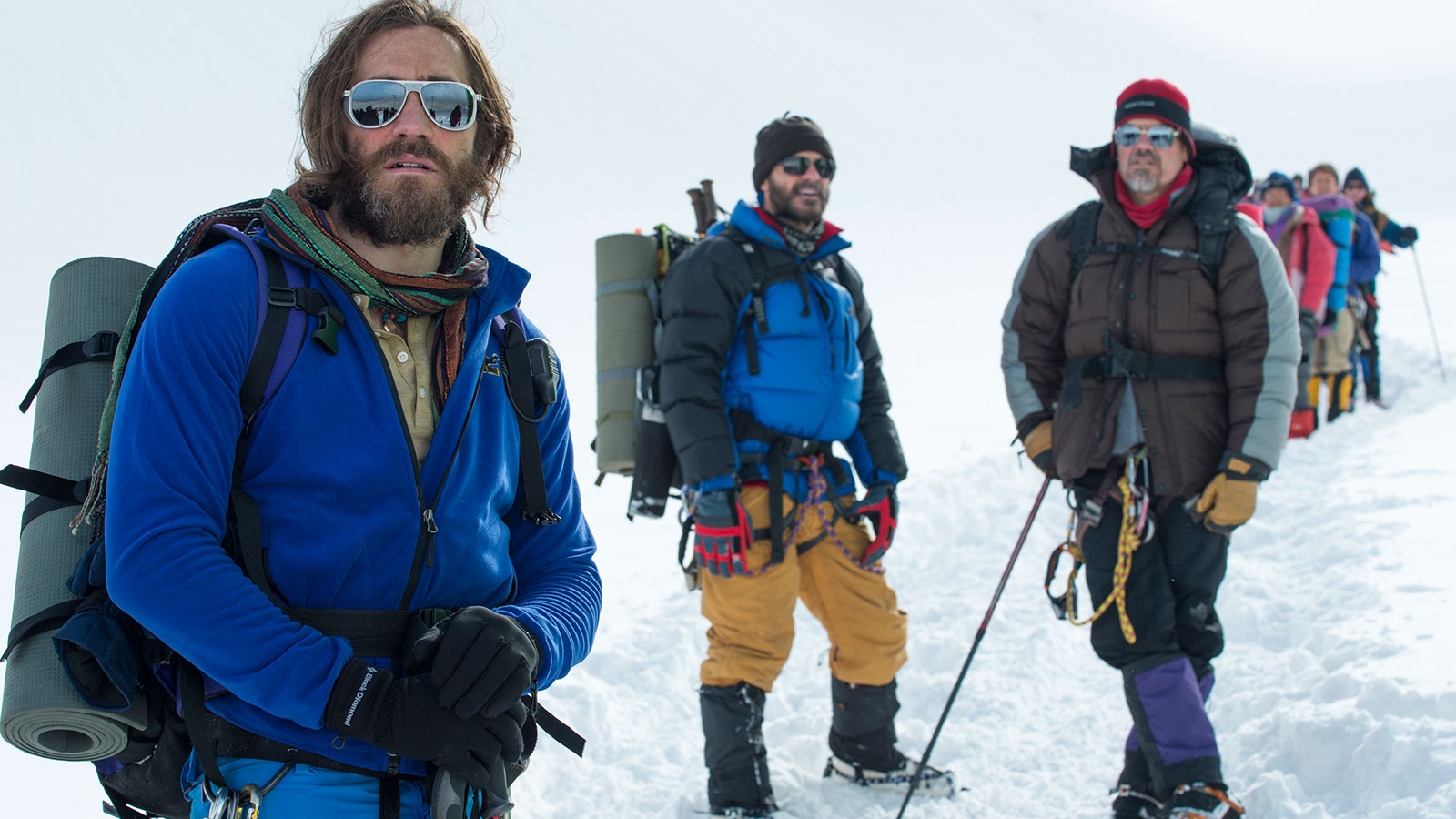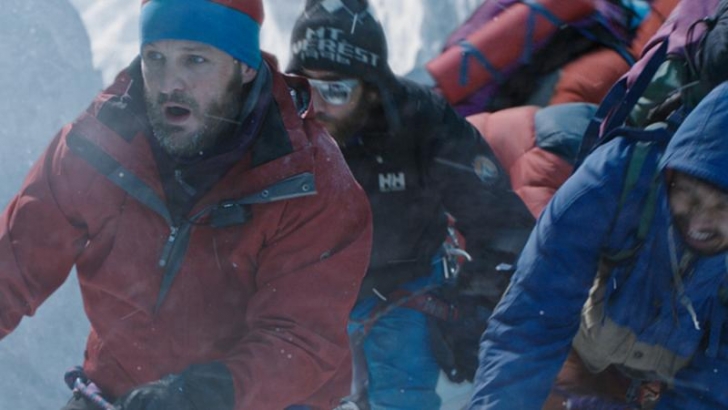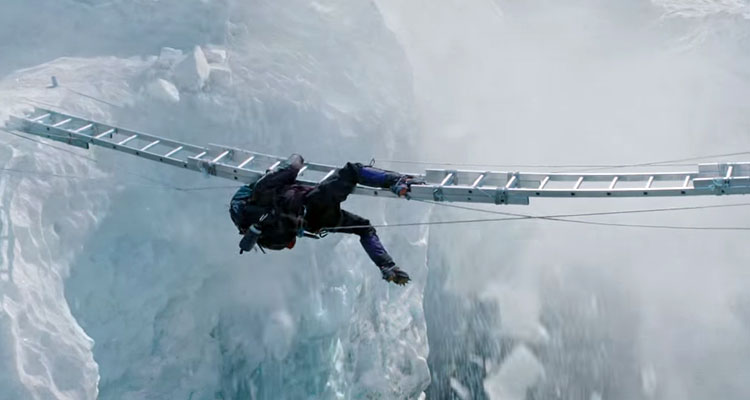Vertical limit.
If a movie has the sacred duty of giving us a sense of place, then Everest has a particularly difficult task in that regard, set in one of the only places on Earth where it would be virtually impossible to actually shoot a movie. Your average key grip, dolly grip and craft services person wouldn’t last five minutes at the peak of Mt. Everest, even if it were possible to airlift them, which it isn’t. If you want to get to the top of the world’s tallest mountain, you have to train for a decade and then climb it. Few have made it, and more than a few have died trying.
You wouldn’t know the summit were virtually unreachable from Baltasar Kormakur’s new film, which plops the viewer down atop wind- and snow-swept crags and slopes that do indeed seem to fly as high as a 747. One of the film’s several triumphs is how it gives you a sense of really being there, despite the series of green screens and snow-making machines that had to have been used in its production. (Some of the lower altitude scenes were actually shot at Everest base camp, though the Italian Alps and Iceland stood in for the higher scenes.)
Creating that sense of place for us previously was American writer Jon Krakauer, whose bestseller Into Thin Air charted the disastrous 1996 climb seen here, and whose book Into the Wild — another true story of quest and loss — was adapted into Sean Penn’s 2007 film. Here, Krakauer himself is a character (played by Michael Kelly), as the stalwart climber was given the assignment of writing 5,000 words on the May 1996 ascent for an outdoor sports magazine. Leading that ascent is Kiwi climber Rob Hall (Jason Clarke), who has made a business of guiding non-professional climbers to the summit for a hefty $65,000 price tag. Hall has led 19 clients to the top and back without loss of life, though he had to abort the previous year’s attempt for the safety of the team. With a group that includes two determined Americans – Texan Beck Weathers (Josh Brolin), who won’t take no for an answer, and postal worker Doug Hansen (John Hawkes), who is making a second consecutive attempt he can’t afford – Hall is feeling extra pressure to make sure the group completes the task this time. The financial future of his family is also foremost in his thoughts, as his wife (Keira Knightley) is expecting a baby girl back in New Zealand. But there’s traffic on the mountain, including a team led by an American hot shot (Jake Gyllenhaal), as the ascent of Everest seems increasingly to have become something every Tom, Dick and Harry thinks he can give a go. As one character observes, though: “The mountain always has the last word.”
Some of the poetry of the title Into Thin Air is lost when you change it to Everest, and so too is some of the poetry of Krakauer’s words when adapted into a feature with a formidable cast and a sprawling budget, expected to appeal to the largest possible audience. The crucial change from the source material, though, is one of perspective. Those who have read Krakauer’s book, who have his voice in their head, will be surprised to find him a secondary character here, almost to the point that he’s incidental to the proceedings. It’s logical that someone like Hall needs to become the protagonist in a big Hollywood movie, as his character is the one who must grapple with the competing responsibilities to his clients and to his family. Every decision Hall makes is a cost-benefit analysis, but a benefit to one is inevitably a cost to another, and you can see this creeping across Jason Clarke’s face as he weighs each choice. This is about as deep as the movie’s themes go, but that’s okay, as this is first and foremost an exhilarating recreation of the fury of nature in its most extreme.
And in that respect Kormakur has really stepped up to the challenge. A veteran of two slick but empty action films, Contraband and 2 Guns, Kormakur shows unexpected maturity in his graduation to a film that is largely free from that type of action. To be clear, this is no Cliffhanger or Vertical Limit, where the wham-bam set pieces are limited only by the imagination of a screenwriter. The events of May 1996 are a matter of public record, as witnessed by the survivors, and the loss of life is almost never depicted as it would be in a work of fiction. In fact, what’s most striking is the way the mountain creeps up on its climbers, as characters who don’t seem to be in any particular trouble are suddenly overcome by physical deterioration, and lost in the blink of an eye. It seems almost random whom the mountain takes and whom it doesn’t, and that’s what’s scariest here.
Perhaps unsurprisingly, Everest also suffers from what has plagued other films involving westerners in tragedy in exotic locales: It spends almost no time developing the locals, who are probably the single most important key to a successful climb. We do meet two Sherpas, one each from two rival teams, but the only unfortunate sense we get of their personalities is that they are territorial and have massive egos. As Everest was first conquered by a westerner, Edmund Hillary, and a Nepalese, Tenzing Norgay, this film definitely needed more Tenzing Norgay. Still, the character development it does do, albeit of good-looking English speakers, pays emotional dividends in the story, as each performance here is a good one. Though the women certainly have less to do, Knightley pours her all into what could have been a thankless role, and it’s particularly nice to see Emily Watson on board as Hall’s logistics person at base camp. Not only does she do a credible Kiwi accent, but she serves as kind of the veteran crampon embedded in the solid rock of this accomplished production.
8/10
For more Reviews, click here. If you’re digging ReelGood, sign up to our mailing list for exclusive content, early reviews and chances to win big!


